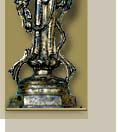Terra-cottas and the Chinese antiques
The Tang were reigning from 648 to 908 AD and they were among the powerful and prosperous dynasties ever known in China. During Tang’s era, the government was getting the most efficient. For instance, the Tang made compulsory the entrance exam of the civil servant. Such exam was applied until the XX° century. The role of the central and local government was extended through a drawing up of a very complete administrative and penal code. The Tang controlled an immense territory: from Korea to Manchuria including Vietnam and Afghanistan.
The main source of Tang’s enrichment was the land incomes. But contrary to the other dynasties, the field’s allocation was fair towards each and every man of the Empire. In compensation, the Tang required each man to enroll during a given duration in the army. For a certain period, this system allowed the Tangs to extend their influence. But it did not last too long: as the population was growing, each person was provided with fewer fields. I did not affect the government incomes but the farmers’ones. Many of them deserted. The government incomes were decreasing and the army was weakening.
The first Tang emperor was Tang Gao Zong. He managed to secure the Silk Road and guaranteed China’s resources for several years. He set up new business partnership: India, Sri Lanka, Korea and Vietnam. During the reign of the second emperor, Tai Zong, the Chinese influence expanded to Japan.
The Tang’s decline was due to some factors but the main reason was the state business neglecting by the Emperor Hsiung Tsun. The latter gave too much power to the queen who took advantage from it and placed her relatives in high positions. Also, many separatist movements appeared in many regions, and then the Emperor sent eminent Generals to stop the revolts. But as the Emperor was too weak, the Generals set their own kingdom and that was the end of the Tang dynasty. |



